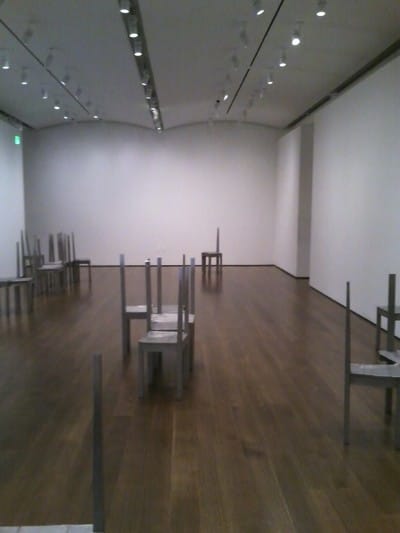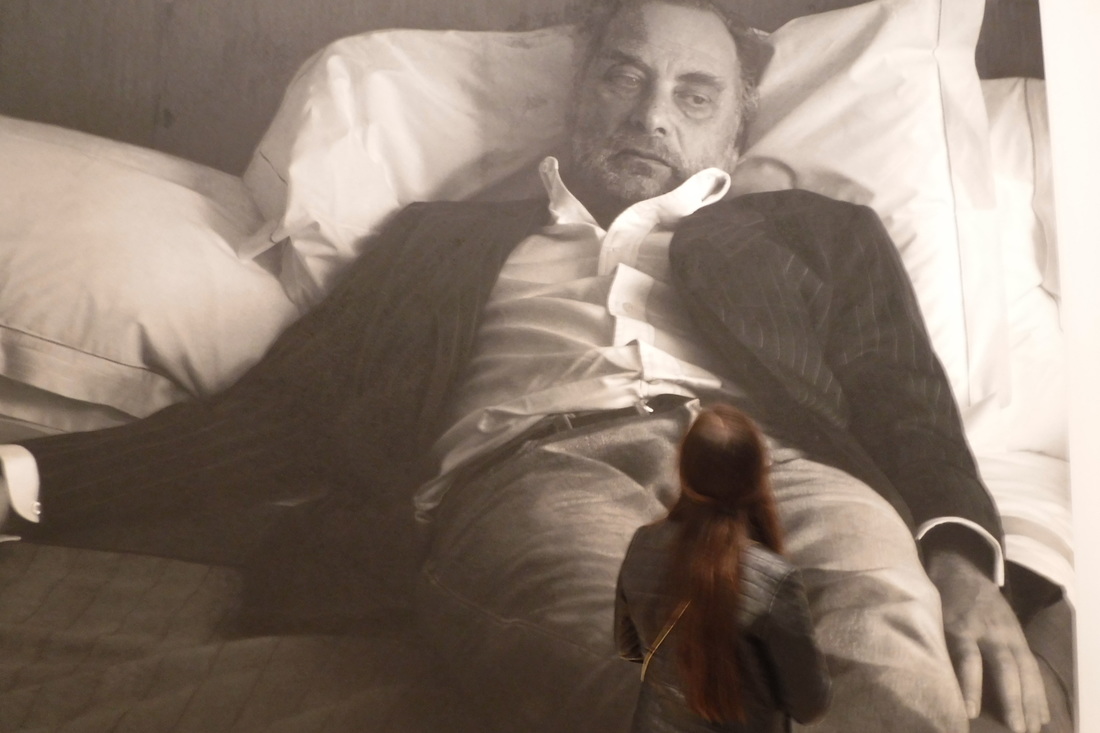|
One I first saw her work at the Institute of Contemporary Art in Boston. Four separate compartments in a wall that contained shoes, and over them, cowhide that was roughly stiched on with black thread, the kind used for stitching gashes in a human body. The shoes, ghostly remnants behind the stitched cowhide, belonged to people who had been murdered in Columbia's civil war. Such a powerful depiction of the concept. The staff person helpfully told me that I could see more of her work at the Fogg Museum at Harvard.
I like to explore all kinds of artists' work because it makes me wonder how I can transfer their ideas to the theater. (Did I just admit to stealing ideas? I think I did!) I l search out someone like Salcedo's work and think, could this be a set for one of my plays? Or I look at work like hers and think what, play could I write with these sculputures in it? At the Fogg we went looking for her exhibition. You know how it goes in museums--sometimes you wander from gallery to gallery, not even knowing what you're looking for, but you know whatever it is, is around here somewhere. It's the nature of elusive art; it's not necessarily working in the same reality we're living in, not playing by the rules we live by, it won't necessarily raise its hand in greeting like a friend saving a seat at a cafe. But on an upper floor we stumbled upon a room filled with sculptures of chairs set willy-nilly in the space, and for a while I stopped looking for Salcedo's work because of the power of the sculpture in that space distracted me from my search. I can continue in a minute, I thought; meanwhile I want to examine this. What struck me was how the artist used and filled the entire space, which is how it is for a theater artist. We fill spaces--we do, that grand empty stage--and someone knew what they were doing with that space. It made me laugh and smile, which I do a lot in museums when I see something that makes me happy, like the time I saw a nail driven into a piece of 2 x 4 and presented as sculpture. Simply brilliant! Sometimes I've had the staff think I was laughing at a piece because I thought it was perhaps silly (like the nail in the 2 x 4!) as if maybe they thought I was some anti-NEA nutjob. Times are a little weird right now. But the laugh is a reaction to pure delight of seeing a work of art just nail what it was saying. It's like "hearing" a language that you can understand, only the hearing is sight behind your eyes and the resonance isn't in your eardrum but in your chest and your brain. And so it was with this exhibition. And of course, you probably knew before me that it was Doris Salcedo's work I was looking at. And here we weren't looking at little shoe-size compartments cut into a wall. These were entire rooms filled, or rather, they commanded the space but not really "filling" it. The pieces filled the space with their power, and not their physicality. One gallery contained individual silk-like sculptures constructed of handwoven silk threads filled with tiny needles, like nasty little booby traps hung on the wall, you put one on and you die from a hundred pin pricks. The size of a shirt, one sculpture could command an entire wall. Another gallery contained a tapestry lying on the floor comprised of thousands of preserved hand-sewn red rose petals (rose petals! sewn together!) the work is intended as a shroud for a nurse who was tortured to death in the Colombian war. Tender and duplicitious, our action and reaction to death.
2 Comments
Trying to "make it"--whatever your definition of that is--as an artist is a constant struggle. I don't think I've ever felt pressure like this, even in my early years as a starving freelancer (starving freelancer/starving artist; they're really one and the same because starving is starving) when I said I would only work for companies who I felt were making the world a better place and with people who I liked. You have your underlying ideals and your principles that form the basis of your company, and you stick to them, and you have faith that by following your heart you'll make it--again, whatever that means, though here with Alley Cat Theater I can define what success is. Part of it my idea of success is sharing ideas like this.
But it's hard enough to be an artist, but if you want to make it doubly hard, here are some hard and fast rules you should follow. You want to break new ground. You want to do something different. You want to build a following for your theater, made up of people who are interested and look forward to the work your theater presents, much in the same way that people anticipate a movie by their favorite director, or a book by their favorite author. And that desire takes up a large portion of the worrying that you do as you build a new theater, trying to figure out how you do it, because in theater, the old try and true methods don't seem to be working anymore.
And then, on a cold, wintry day after Christmas, when you and your wife are out trying to find that place where you can rent kayaks in the summer on the estuary that leads out onto the bay, you stumble upon an unkempt amphitheater, something that looks like something out of ancient Greece. And you suddenly remember that play your friend has that would be perfect for this setting, and you think of the short play that you have, and maybe some of your friends have other short plays you can present (and you think, of course they have short plays I can present; the problem I'll have is having too many short plays) and imagine the stone steps filled with people, and lights coming on on a summer night, and microphones--will they need microphones, or will the actors project?. And the next day you look at the pictures, and the theater looks definitely like a fixer-upper, the kind of place where you fall in love, and only you can see the beauty and possibility. If anyone who's reading this knows how I can get this done in Quincy, Massachusetts, please message me. Let's put on plays in the park in the summer, giving people a chance to put down their phones and sit together on a balmy summer night and listen to stories and laugh and cry a bit, and go home, maybe changed just a little bit. My medium is everything available in the traditional theater (e.g. lighting, costumes, dialogue, sound) as well as non-traditional theatrical elements (e.g. movement, multimedia (video), puppetry, magical realism) to address burning issues of our times, e.g. Turtles and single mothers and Plank and individual rights and climate change. My purpose for using non-traditional elements isn’t for the shock value, but for the way they force people to look at “normal” things differently. I investigate the theater world in the same way painters—abstract expressionist, for example—explore and push the boundaries of the canvas, only instead of painting pictures, I’m telling stories by pushing the boundaries of the theater. I’m inspired by any artist who pushes the limits of their medium. Examples of these techniques in my work include:
My vision is Alley Cat Theater, a diverse theater that promotes and introduces Boston audiences to new, non-traditional work addressing today’s issues. |
Alley Cat TheaterAlley Cat Theater produces new work that is intelligent, compelling, and thoughtful, telling stories by pushing the boundaries of the theater. Archives
December 2017
|
|
Alley Cat Theater has been funded by The Boston Foundation as part of the Live Arts Boston initiative, Eastern Bank Charitable Foundation, and the Bob Jolly Charitable Trust.
|
Proudly powered by Weebly













 RSS Feed
RSS Feed



